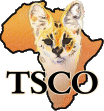����� �����
����� �����
����� �����
����� �����
�����
�����
�����
�����
����� �����
����� �����
����� �����
�����
|
|
|
African Serval Feeding and Nutrition
In the wild, Servals are by nature carnivores and depend primarily on a diet of rodents, birds, frogs and insects. Based on the nutritional ingredients provided to them in the wild, the captive bred Serval diet has been formulated to equal or come close to what is needed in the Serval�s diet.
A link to serval kitten information can be found at the bottom of this page.
Most commonly used diets today for the captive bred Serval are:
1. Commercially produced diets
2. Raw diet with supplements
The Serval diet should consist of mostly meat, feeding about 2% - 3% of body weight daily. Judgment needs to be used concerning the Servals age, health, energy and if reproducing.
*Requirements that should be in the Serval diet:
Protein, Vitamin A, D3, E, C, B1, B2, B6, B12, Sodium, Potassium, Calcium, Phosphorus, Iron, Manganese, Ash, Iodine, Folic Acid, Choline, Taurine.
An added supplement to the diet can contain the necessary vitamins and nutrients needed on a daily bases.
*There are several commercially produced diets used for the Serval. Some are:
1. Nebraska
2. Mazuri
3. Zupreem (comes in can form)
These commercial diets do contain the needed vitamins and nutrients needed by the Serval. However each Serval's nutritional needs may differ, so many prefer to use the raw diet to maximize and maintain bases for needed vitamins and nutrients.
*Raw Diet
1. Meat: horse meat, beef, etc
2. Poultry: Chicken legs, chicken leg quarters, chicken gizzards, hearts and liver, turkey leg or turkey thighs, pheasant, duck, quail
3. Medium sized rodents and chicks (purchase frozen and thaw when needed).
4. Daily vitamin and nutrient supplement added to the meat:
Examples but not limited to: Oasis Supplement, Mazuri Supplement, Wild Trax Supplement, Centrum Tablet (crushed), NuVet Plus
Using a raw diet: (some items pertain to produced diet as well)
1. Never cook meat, keep raw. Bones become brittle upon cooking and can cause serious internal damage to the Serval
2. Always store meat correctly, and clean or wash (sanitize to help lessen chance of bacteria growth)
3. Use of stainless steel containers for feeding bowls is preferred
4. Always clean and sanitize any utensils used as well as feeding bowls after every use.
Facts to Remember:
1. Soft diet consistency may contribute to poor oral hygiene
2. Give meat with bones attached (some exceptions on chicken bone)
3. Frozen meats, thaw in refrigerator
4. Too much food leads to less active Serval and weight problem
5. Occasionally change diet, keep records
6. Use of whole prey and/or bones with meat can be used
7. Some types of food that can be used as enrichment or treats:
Fish
Live fish
Crickets
Some types of vegetables or fruit
Jarred chicken or turkey baby food, not containing sodium, garlic powder or onion powder
*** Note: This Serval diet information is only basic and can or may differ for each Serval and/or experienced caretaker. ***
Hand-Rearing And Bottle Feeding Serval Kittens
Click, Opens A New Page
Please Visit Our Serval Gift Store.

|
|

